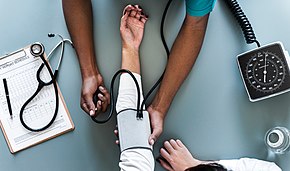Blood pressure
| Blood pressure | |
|---|---|
| Medical diagnostics | |
 A healthcare worker measuring blood pressure using sphygmomanometer. | |
| MeSH | D001795 |
| MedlinePlus | 007490 |
| LOINC | 35094-2 |
Blood pressure is a measurement used in medicine. In the body, the arteries carry blood away from the heart. As blood travels through the arteries, it presses against the walls of the arteries. Blood pressure measures how hard the blood is pushing against the walls of the arteries.[1]
Usually, "blood pressure" measures the pressure in larger arteries delivering blood to body parts other than the lungs, like the brachial artery in the arm. Blood pressure is usually measured in millimeters of mercury (mmHg).
There are two numbers in a blood pressure. The first is the systolic pressure. It measures how hard the blood pushes against the walls of the arteries when the heart is in systole (beating and pushing out blood). This is when the pressure against the walls of the arteries is highest. The second number is the diastolic blood pressure. It measures how hard the blood pushes against the walls of the arteries when the heart is in diastole (resting between beats and not pushing out any blood). For example, in the picture on this page, the pressure on the walls of the arteries is 122 mmHg when the heart is beating, and 65 mmHg when the heart is resting. This blood pressure would be written as "122/65" and read as "122 over 65."
Mean arterial pressure is a person's average blood pressure. Pulse pressure is the difference between the systolic and diastolic pressures.[1]
To measure blood pressure, doctors use a device called a sphygmomanometer.
Normal Blood Pressure
[change | change source]
Blood pressure is usually lower for children and gets higher as a person gets older.[1]
For healthy adult humans, the systolic blood pressure should be below 120, and the diastolic blood pressure should be below 80.[2] However, blood pressure can be very different for each person. Blood pressure also changes naturally during the day (in a circadian rhythm). It gets lower during sleep and gets higher when a person gets up. It is lower when a person is resting and higher during activity.[3] Many other things - like stress, disease, drugs, and what a person eats - can change blood pressure.[3] Even the stress of having blood pressure taken can make it higher. This is called "white coat hypertension."[4]
Blood Pressure Problems
[change | change source]People can have health problems if their blood pressure is too high or too low.
High blood pressure
[change | change source]High blood pressure is called hypertension. A person has hypertension if their blood pressure is high and stays high over time. Hypertension is very common. About one in every three adults in the United States has high blood pressure.[3] Hypertension is sometimes called "the silent killer" because it often causes no symptoms, so many people have high blood pressure without realizing that anything is wrong.[3] However, hypertension can hurt the heart, blood vessels, kidneys, and other parts of the body.[5] It can cause serious health problems like heart attack, stroke, and kidney failure.[5]
Low blood pressure
[change | change source]Low blood pressure is called hypotension. If the blood pressure is too low, the heart, brain, and other parts of the body do not get enough blood and oxygen.[6] Low blood pressure can cause problems like dizziness and fainting. If a person's blood pressure is low enough, they can have seizures, lose consciousness, and even die.[6]
Related pages
[change | change source]References
[change | change source]| Definitions from Wiktionary | |
| Media from Commons | |
| News stories from Wikinews | |
| Quotations from Wikiquote | |
| Source texts from Wikisource | |
| Textbooks from Wikibooks | |
| Learning resources from Wikiversity | |
- ↑ 1.0 1.1 1.2 "Understanding Blood Pressure Readings". American Heart Association. 2014-08-04. Retrieved 2015-01-03.
- ↑ Pesola GR, Pesola HR, et al. 2001 (2001). "The normal difference in bilateral indirect blood pressure recordings in normotensive individuals". American Journal of Emergency Medicine. 19 (1): 43–5. doi:10.1053/ajem.2001.20021. PMID 11146017. Archived from the original on 2011-04-05. Retrieved 2009-04-04.
{{cite journal}}: CS1 maint: multiple names: authors list (link) CS1 maint: numeric names: authors list (link) - ↑ 3.0 3.1 3.2 3.3 "What is High Blood Pressure?". National Heart, Lung, and Blood Institute. 2012-08-02. Retrieved 2015-01-03.
- ↑ "Home Blood Pressure Monitoring". American Heart Association. Retrieved 2013-02-14.
- ↑ 5.0 5.1 Lewington S, Clarke R, et al. 2002 (2002). "Age-specific relevance of usual blood pressure to vascular mortality: a meta-analysis of individual data for one million adults in 61 prospective studies". Lancet. 360 (9349): 1903–13. doi:10.1016/s0140-6736(02)11911-8. PMID 12493255. S2CID 54363452.
{{cite journal}}: CS1 maint: multiple names: authors list (link) CS1 maint: numeric names: authors list (link) - ↑ 6.0 6.1 "What Are the Signs and Symptoms of Hypotension?". nhlbi.nih.gov. National Institutes of Health. November 1, 2010. Retrieved 2014-02-17.
